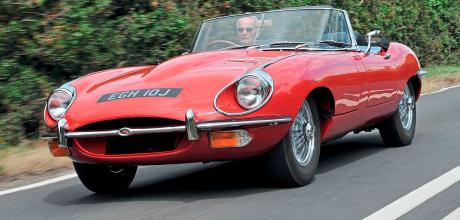Modern automatic transmission technology meets the Jaguar E-type
We discover the startling transformation which can be gained from applying modern gearbox technology to older Jaguars.
WORDS AND PHOTOGRAPHY PAUL WAGER
Box fresh Six-speed E-type Transformed by modern gearbox tech.
Modern automatic transmission technology meets the E-type and XJ-S with devastatingly effective Results.
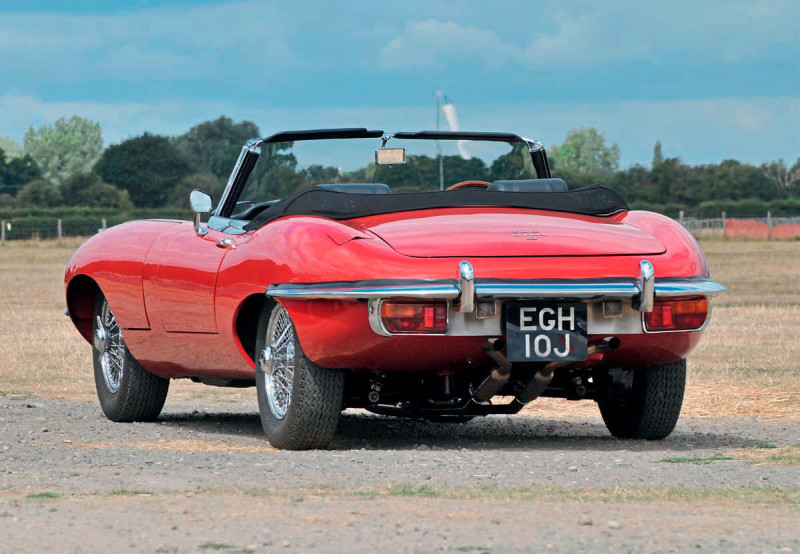
Drove an Austin Seven the other day – one of my all-time favourite classics and of course the car which also got Jaguar started in the car-building game. With just three non-synchro gears and a feeble 17bhp from the 747cc engine it still manages to put a smile on your face, yet it also illustrates perfectly how far the science of automotive engineering has come. These days an engine of that size would be turbocharged and festooned with electronics to the point where it wouldn’t be far off the power output of an X-TYPE from just 20 years ago.
Pretty much all parameters of gearbox operation can be adjusted through the control software using a laptop.
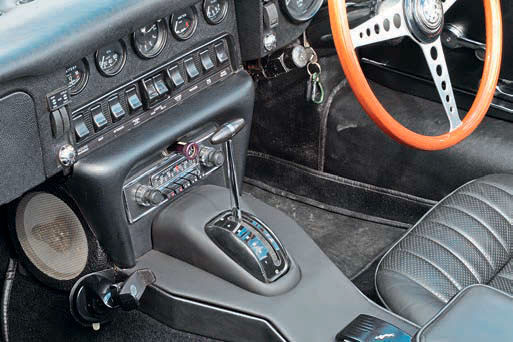
One thing which often gets overlooked though is that the march of progress and the quest for green credentials has seen the science of transmission design advancing just as far as engine design.
It’s the clever automated manuals which get the headlines, especially the twin-clutch DSG-type boxes, but what’s often overlooked is that the traditional torque converter automatic hasn’t gone away and in fact has quietly evolved to the point where it’s unrecognisable as a descendant of the jerky old Borg Warner and Hydramatic units fitted to older Jaguars.
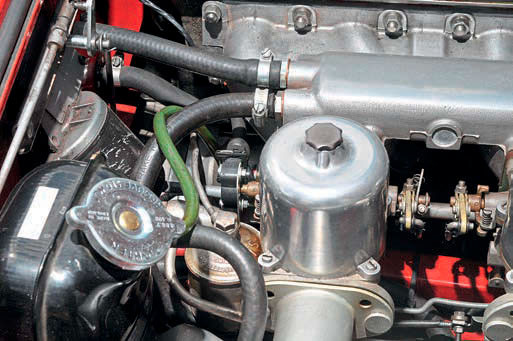
With the theme of this issue of JW being modified Jaguars, naturally we’ve tended to concentrate on the engine tuning side of things, a science notorious for dwindling returns as cost increases.
What, though if you were able to replace the antique automatic gearbox technology with something more modern and make more efficient use of the power you already have?
Someone who has already been through that exact thought process is Andrew Parkinson at Kent-based Jaguar specialist Motor Legends. It started when company proprietor Keith Perkins returned from a trip to New Zealand, bringing with him a barn-find Series 3 E-type. The car was restored to original specification since Keith wanted the convenience of the self-shifter yet it wasn’t long before he found himself feeling the old three-speed Borg Warner Type Model 12 gearbox really rather stifled the V12’s performance.
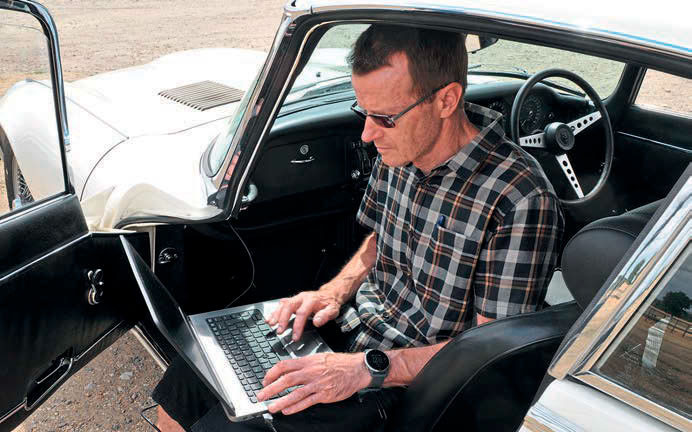
Andrew was duly challenged with the task of researching a more modern automatic which could serve as a replacement, but this wasn’t the simple tape-measure-and-welder task you might think. For one thing, the gearbox had to physically fit the available space but more crucially, the majority of modern computer-controlled automatics are designed to work in conjunction with the engine management electronics of the car they were originally installed in. When removed from their original home, there’s simply no way of accessing the control electronics and naturally the OEM gearbox makers aren’t keen on helping out.
However, it was during a trip to the gigantic SEMA aftermarket tuning show in Las Vegas that a plan came together when the Motor Legends duo noticed the popularity of the Ford 6R80 as found in the current Mustang. Originally a ZF design known as the 6HP which was later licensed by Ford, this six-speed box uses standalone control electronics and so can be used without the rest of the Mustang wiring loom.
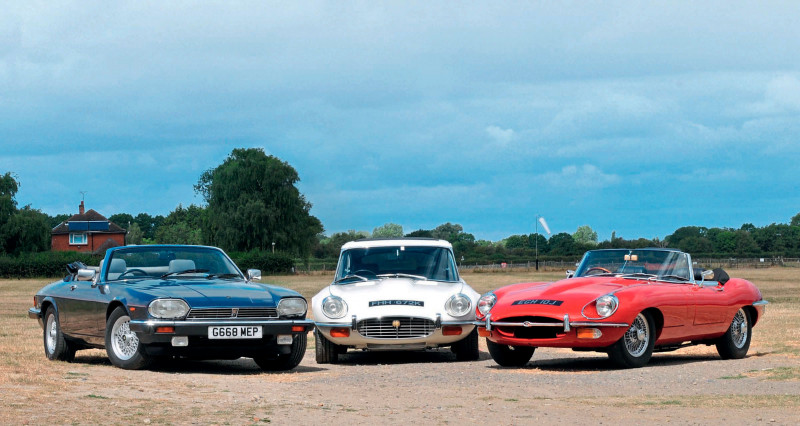
All they needed was a suitable control interface and again, the SEMA halls obliged when they found a firm producing aftermarket gearbox control interfaces. Yes, they could develop a similar controller for the Mustang gearbox and the end result was that Keith’s E-type duly gained a six-speed transmission and a transformation in its driving dynamics.
And if you think this sounds familiar, then you’re right: we featured the converted E-type in our August 2021 issue and such was former editor Walton’s praise of the conversion that when we discovered that Motor Legends had applied the idea to more Jaguars, I was keen to sample it for myself. The big news was that the team had successfully installed the Mustang box into a six-cylinder E-Type, a much more involved undertaking than the V12 car owing to the smaller size of the transmission tunnel.
The car in question was a series 2 roadster, which readers familiar with E-type history will realise creates a car never offered by Jaguar in period. The BorgWarner automatic option was introduced with the Series2model in 1966 but was only ever offered from the factory in the longer-wheelbase 2+2 coupe until the advent of the Series 3 which used this longer chassis for both roadster and coupe models.
All of which means that a short-wheelbase, open Series 2 E-type never existed – or at least, it didn’t until Motor Legends customer Andrew Morgan offered up his car as a guinea pig. Unlike most of us, Andrew was quite happy to admit to himself that in reality a classic sports car can still be enjoyed without clutch pedal and gear lever and that living in the congested South East, he was in fact likely to make more rather than less use of his Jaguar if it offered the convenience of an automatic.
Accepting the challenge, the Motor Legends workshop got busy. Chief obstacle was the transmission tunnel of the six-cylinder cars which is noticeably narrower than the V12 and required more work to accommodate the Ford box than the V12 car had required. The elegant solution adopted was to remove the existing tunnel and replace it with the wider V12 part, which adds an additional 20mm of room on each side.
Naturally, much work with templates and dummy installations was involved but the neatly carpeted result is impossible to tell at a glance from standard. Except, that is, the lack of a handbrake. Andrew explains that even with the V12 tunnel, there’s simply no room in the six-cylinder cars for the handbrake pivot and operating mechanism in its standard position, something which prompted a brilliant bit of lateral thinking. Once again, the aftermarket came up trumps with an electronic handbrake popular among kit and replica car makers – and since so many of these cars use the Jaguar IRS, it was ideal for the E-type.
Operated by the spare dashboard switch provided for the heated rear window of the hardtop, it’s also wired to activate when the shifter is moved to park and operates much like a modern car.
The shifter itself is the familiar slender T-bar you’d find in a contemporary factory automatic car, complete with the plastic surround and brushed gate, meaning that the end result is that this really does look like a factory-quality job. Certainly if you weren’t familiar with E-type history you would never notice that the automatic shifter doesn’t belong inside a Series 2 roadster.
After the bodywork mods, the mechanical aspect of the conversion is relatively straightforward, the bellhousing of the Ford box mated to the XK engine with a precision machined adapter plate and the new gearbox controller mounted inside the car out of harm’s way. There’s a new propshaft of course, while a transmission oil cooler hides inside the E-type’s long nose, the exhaust is re-routed around the gearbox sump and a throttle position sensor (required for the control software) is neatly mounted on to the carburettor spindle.
It’s the controller which is central to the success of the conversion, since it allows the gearbox behaviour to be mapped to an individual car using a laptop – and on the move if required.
Pretty much all the operating parameters of the box can be adjusted via the screen, with road speeds, gearshift speed and torque converter lock-up all carefully dialled in over many hours of road testing.
This allows the gearbox ‘map’ to be tailored to a customer’s preference, with the set-up on Keith’s V12 noticeably more aggressive than the softer programming on Andrew’s car which is biased more towards brisk road driving and refinement rather than out-and-out performance. In theory it’s even possible to install two gearbox maps and switch between them with a suitably discreet ‘sport’ button but so far that’s an option that hasn’t been requested. In a similar vein, it’s also in theory possible to add steering wheel-mounted paddles to control gearshifts, although this would look rather out of place in the E-type.
As ever though, a real test of a conversion like this is how it drives and a sunny morning in rural Kent provided the ideal opportunity. Naturally it helped that Andrew’s red roadster is simply one of the nicest E-types I’ve sampled for some time. Clearly a very well-sorted car, it drives with a precision which sadly is sometimes lacking even in expensively restored examples and in this respect it made a very good basis to evaluate the gearbox upgrade.
Long ago I realised that the real test of modified and upgraded cars is how well they perform at the kind of sedate speeds required by everyday life: all too often a car which impresses with blistering straightline performance can be a hesitant, jerky nightmare to drive in busy traffic but I’m happy to report that the Motor Legends conversions simply shrug off the challenge of daily life.
Pulling away from a standstill on the gravel car park of our photo location, the hours of mapping work have clearly paid off, with the torque converter dialled in nicely to the power curve of the XK engine. There’s no hesitant revving waiting for forward drive to kick in and no sudden wheelspin and shower of gravel, either. Pulling out on to a main road and picking up speed gently on a light throttle, the main impression is just how unobtrusive the gearbox is as it does its stuff, quietly easing up through the gears and as we’re distracted chatting about cars in general and E-types in particular, I almost fail to notice the revs dipping slightly as the torque converter locks up in fourth gear. On this car the lock-up is programmed for fourth, fifth and sixth gears and the result is that on an E-type with the 3.07:1 final drive the engine speed in top gear is massively reduced, from 2700rpm at 70 mph to a leisurely 1700rpm with obvious benefits in refinement and economy.
Easing back on to the throttle after clearing a village, the converter unlocks just as unobtrusively and when we move out to overtake a slow-moving truck, the awkward wait and thumping kickdown of the old three-speed BorgWarner is a distant memory as the modern box slips down a couple of ratios and we’re immediately in the power band.
Later on, when we find ourselves in stationary traffic, the six-speed E-type proves an equally easy car to live with and it’s at this point that I see what Andrew meant about using the car more if it had an automatic box. Even on a hot summer’s day the electronics and gearbox behave faultlessly and the roadworks suddenly aren’t the rage-inducing hold-up they would be if I were pumping a heavy clutch and awkward ’60s manual shift every couple of minutes.
As you’ve probably no doubt realised by now, I walked away from the red roadster with a whole new take on the science of modifying older cars. Certainly to improve the driving dynamics of an E-type this much through the traditional engine tuning route would be colossally costly and at the end of the day you’d still be grappling with either a four-speed manual or a clunky three-speed auto.
As the popularity of automatics in the new car market proves, you don’t have to suffer from mobility issues to see their appeal and this conversion elegantly achieves the combination of classic and modern.
THE BOTTOM LINE
Six-speed conversions from Motor Legends start at £12,540 including VAT although the amount of work varies depending on the model – the six-cylinder E-type is the most challenging, the V12 E-type less so and the XJ-S relatively straightforward. No, it may not be the cheapest upgrade you’ll ever make to your Jaguar but it compares favourably to the cost of rebuilding or replacing an ailing standard unit, whether manual or automatic and it will transform the car’s appeal.
Find out more at www. motorlegends.co.uk or on 01622 673 404
The hours of mapping work have clearly paid off
LEFT: Throttle position sensor is neatly mounted on throttle shaft.
RIGHT: Shifter itself is period correct.


